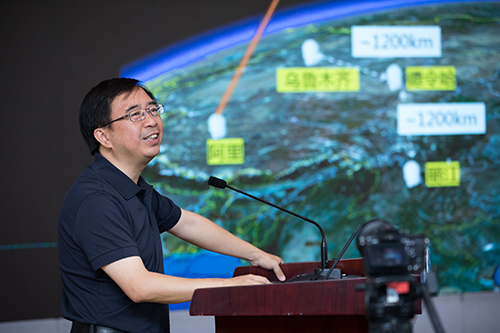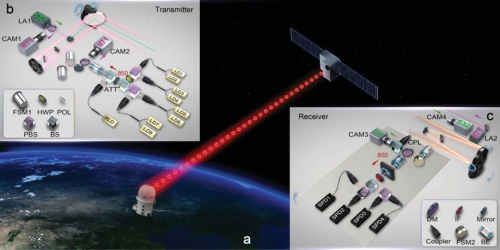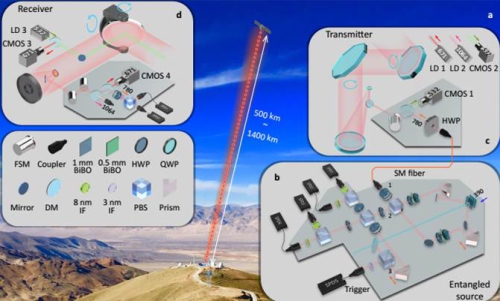

The Chinese Academy of Sciences (CAS) recently held a press conference to announce that China's quantum satellite Micius achieved the world's first successful satellite-to-ground quantum key distribution and ground-to-satellite quantum teleportation. Both achievements were published online by the journal Nature on August 10.
They were major breakthroughs for Chinese scientists in quantum physics research in space via the quantum satellite Micius, also known as the Quantum Experiments at Space Scale (QUESS) satellite. Previously, Chinese scientists had been the first in the world to achieve satellite-to-ground bidirectional quantum entanglement distribution over a distance on the order of 1,000 kilometers, and the first to conduct tests for quantum non-locality. Science published a cover story on the studies.
The three achievements signaled that Micius has fulfilled all its designated scientific goals ahead of schedule, laying solid scientific and technological foundations for China to continue to lead in the development of quantum communication technologies and to advance the frontiers of research in verification of basic theories of quantum physics in space.
CAS President Bai Chunli attended the press conference and delivered a speech.
Supported by the CAS Strategic Priority Program on Space Science, the latest experiments were jointly conducted by a research team led by Pan Jianwei, a CAS academician and physicist at the University of Science and Technology of China, and his colleague Peng Chengzhi, with a research team led by Wang Jianyu at the Shanghai Institute of Technical Physics of CAS, the Micro-satellite Innovation Institute, the Institute of Optics and Electronics, the National Astronomical Observatories, the Purple Mountain Observatory, the Nanjing Astronomical Instruments Co, and the National Space Science Center.
One aspect of the quantum communication research concerns quantum key distribution.
Communication security is fundamental to national information security as well as humans' economic and social activities. For thousands of years, man has been ceaselessly pursuing secure communication. However, in theory conventional cryptography based on computational complexity is subject to being cracked. With progress in mathematics and computational capability, classical cryptography has become increasingly vulnerable.
Unlike classical communication, quantum key distribution allows distant parties to share an unconditionally secure encryption key through transmission of quantum states, and use it as a one-time pad to encode the message. It is the only unconditionally secure communication method known so far because it is impossible to wiretap or crack the information transmitted this way.
Another important aspect of quantum communication is quantum teleportation, which allows transmission of an unknown quantum state of matter to a distant point without the need for actual transmission of the matter itself. Long-distance teleportation is a building block for quantum networks for distributed quantum information processing.
Quantum communication usually uses single photons as physical carriers of information. The most straightforward means of transmission are optical fibers or terrestrial free-space channels, but the channel loss of both exponentially reduces the photon rate over long distances. In addition, quantum signals can’t be amplified by classical means due to the no-cloning theorem. As a result, the previous world record for quantum communication was limited to a distance of the order of 100 kilometers. In the past few decades, practical realization of secure long-distance quantum communication has remained the biggest challenge as well as a common goal of the international science community.
By exploiting the near-vacuum of space, where photon loss is negligible, scientists are able to expand quantum communication to significantly longer distances with the help of satellites. Meanwhile, satellites offer the most promising means for realizing practical quantum cryptography and teleportation over ultra-long distances and on a global scale as they possess the unique advantage of being able to conveniently cover the whole Earth.
Since early this century, international science communities have shifted their focus to this field, resulting in fierce competition.
Pan's team carried out a series of pioneering experiments with regard to satellite-ground quantum communication. In 2003, they put forward a plan to utilize satellites for establishing quantum communication links between space and ground and build global-scale secure quantum communication networks.
In 2004, the team achieved bidirectional free-space distribution of entangled photon pairs over a distance of 13 kilometers – well beyond the effective thickness of the atmosphere – for the first time in the world, thus verifying the feasibility of quantum communication through the atmosphere.
At the end of 2011, the QUESS program was officially launched under the CAS Strategic Priority Program on Space Science. In 2012, the CAS collaborative research team led by Pan conducted experiments above Qinghai Lake, the largest lake in China, and achieved the world's first quantum entanglement distribution and quantum teleportation over a distance of the order of 100 kilometers. That result fully verified the feasibility of satellite-based quantum communication.
In 2013, the CAS collaborative research team conducted quantum key distribution experiments above Qinghai Lake that simulated satellite-ground relative motion and a high-loss scenario of satellite-ground links, which verified from all perspectives the feasibility of satellite-to-ground quantum key distribution.
From that point on the team's painstaking efforts led to the successful development of the Micius satellite after overcoming numerous difficulties. The satellite was launched from the Jiuquan Satellite Launch Center in Jiuquan, northwest China's Gansu province on August 16, 2016. After four months of in-orbit testing, it was officially delivered on January 18, 2017 for the purpose of conducting scientific experiments.
Micius was designed to facilitate satellite-to-ground high-speed quantum key distribution. In the experiments, the satellite beamed quantum signals to ground receiver stations. When it flew over China, an optical link was established between the satellite and a ground station in Xinglong, in north China's Hebei province. The communication distance between the satellite and the ground station varied from 645 to 1,200 kilometers. At 1,200 kilometers, the quantum key transmission rate from satellite to ground was up to 20 orders of magnitude (100 quintillion times) more efficient than that expected using an optical fiber of the same length.
The light source for decoy-state quantum key distribution on board the satellite sent an average of 40 million signal photons per second, and was capable of generating 300 kbit secure key at an average rate of 1.1 kbps every time the satellite flew over China.
The achievement consolidated the technological foundation for building global secure quantum communication networks. On the basis of satellite-to-ground quantum key distribution, the satellite, as a trusted relay, can be used to realize key sharing between any two points on Earth, so that quantum key distribution can be extended to cover the globe.
In addition, Earth-space integrated secure communications networks covering the whole world can be built through connecting ground stations with intercity secure quantum networks using optical fibers; examples are the quantum communication networks in Hefei and Jinan and the Beijing-Shanghai trunk line.
A reviewer from the journal Nature commented that the experiment was an impressive achievement, and constituted a milestone in the field, adding it would no doubt draw high attention from scientists in quantum information, space science and other fields, as well as from the general public, and that public media would report on it extensively.
Another experiment, on ground-to-satellite quantum teleportation, was also conducted via Micius. In the experiment, a ground station in Ali, Tibet autonomous region, at an altitude of 5,100 meters, sent entangled photons to the satellite. When Micius flew over China, an optical link was established between the satellite and the station.
The light source at the ground station generated 8,000 quantum teleportation cases per second, and entangled photons were sent from ground to satellite over distances ranging from 500 to 1,400 kilometers. The confidence interval for all six quantum states to be transmitted exceeded 99.7 percent, higher than classical limits. Had the same work been repeated in an optical fiber of the same length, it would have taken 380 billion years (i.e., 20 times the age of the universe) to observe merely one case.
This important experiment set a reliable technical foundation for carrying out future research in quantum communication at space scale, as well as experiments and tests concerning quantum physics and quantum gravity in space.
The aforesaid Nature reviewer hailed the achievements as "major breakthroughs in research and progress in the novel and challenging field of long distance quantum communication".
The Chinese-developed Micius satellite was the world's first quantum satellite, as well as one of the four scientific satellites supported by the CAS Strategic Priority Program on Space Science during the 12th Five-Year Plan (2011-15). CAS led efforts ranging from proposing scientific concepts to making breakthroughs in key technologies, and from organizing implementation of the project to delivering scientific outcomes.

Professor Pan Jianwei introduces the latest achievements made by Micius. (Image from cas.cn)

Satellite-to-ground high-speed quantum key distribution (Image from cas.cn)

The ground-to-satellite quantum teleportation experiment (Image from cas.cn)
Source: cas.cn